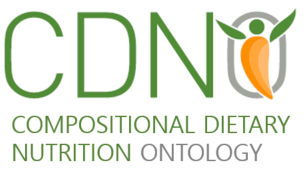The CDNO provides structured terminologies to describe nutritional and other attributes of material entities that contribute to human diet. These terms are intended primarily to be associated with datasets that quantify concentration of dietary chemical components derived from samples taken from any stage in the production of food raw materials (including from crops, livestock, fisheries) and through processing and supply chains. Additional knowledge associated with these dietary sources may be represented by terms that describe functional, physical and other attributes.
Whilst recognising that dietary components within food substrates may be present as complex and dynamic physical and chemical structures or mixtures, CDNO focuses on components typically quantified in an analytical chemistry laboratory. The primary CDNO class ‘dietary chemical component’ contains hierarchical sets of terms organised to reflect commonly used classifications of chemical food composition. This class does not represent an exhaustive classification of chemical components, but focuses on structuring terms according to widely accepted categories. This class is independent of, but may be used in conjunction with, classes that describe ‘analytical methods’ for quantification, ‘nutritional functional attribute’, ‘dietary material physical attribute’ or ‘dietary role’. Quantification data may be used and reported in research literature, to inform food composition tables and labelling, or for supply chain quality assurance and control.
More specifically, terms within the ‘chemical component concentration’ class may be used to represent quantification of components described in the ‘dietary chemical component’ class. Concentration data are intended to be described in conjunction with post-composed metadata concepts, such as represented by FoodOn ‘Food product by organism’, which derives from some food or anatomical entity and a NCBI organismal classification ontology (NCBITaxon) entity. In addition, one or more CDNO analytical method term may be used to describe the process used to acquire concentration data, where these terms may be inherited from the Ontology for Biomedical Investigations (OBI), the Chemical Methods ontology (CHMO) or the Physico-chemical Methods and Properties ontology (FIX). In combination these formalise the language used to describe sample source and status in the crop production/food supply chain.
Additional knowledge relating to interactions of food components with human physiological function is embodied within the CNDO dietary function class, where a nutritional component may be associated with one or more functional categories.
The common vocabulary and relationships defined within CDNO should facilitate description, communication and exchange of material entity-derived nutritional composition datasets typically generated by analytical laboratories. The organisation of the vocabulary is structured to reflect common categories variously used by those involved in crop, livestock or other organismal production, associated R&D and breeding, as well as the food processing and supply sector, and nutritionists, inlcuding compilers and users of food composition databases. The CDNO therefore supports characterisation of genetic diversity and management of biodiversity collections, as well as sharing of knowledge relating to dietary composition between a wider set of researchers, breeders, farmers, processors and other stakeholders. Further development of the functional class should also assist in understanding how interactions between organismal genetic and environmental variation contribute to human diet and health in the farm to fork continuum.
A more descriptive guide for the Crop and now Compositional Dietary Nutrition Ontology (CDNO) was published in Crop Science in an article by Andres-Hernandez et al. 2020 doi:10.1002/csc2.20092.
More information can be found at http://obofoundry.org/ontology/cdno
The latest version of the ontology can always be found at:
http://purl.obolibrary.org/obo/cdno.owl
(note this will not show up until the request has been approved by obofoundry.org)
Editors of this ontology should use the edit version, src/ontology/cdno-edit.owl
Please use this GitHub repository's Issue tracker to request new terms/classes or report errors or specific concerns related to the ontology.
If you use the ontology, please cite its IRI: http://obofoundry.org/ontology/cdno
If you mention CDNO in a paper, please cite one of the following: Andrés‐Hernández, L., Baten, A., Azman Halimi, R., Walls, R., & King, G. J. (2020). Knowledge representation and data sharing to unlock crop variation for nutritional food security. Crop Science, 60(2), 516-529. doi.org/10.1002/csc2.20092
Please use the issue tracker for comments, requests for new terms, and suggesting changes to existing terms.
CDNO curator Liliana Andres Hernandez Email: [email protected] Linkedin: https://www.linkedin.com/in/liliana-andres/
















